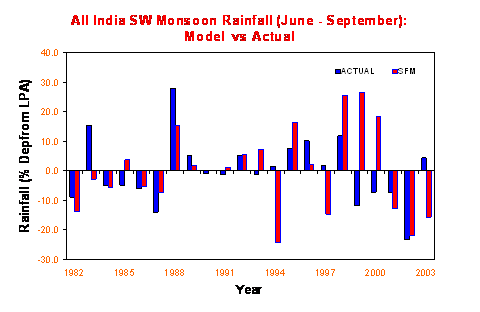Dynamic Predictions
Though the statistical approach has provided some useful predictive skill, it has not shown significant improvement in the skill during the last several decades due to inherent problems such as the non-stationarity of the climate data series, inter correlation among the predictors, changing predictability, uncertainty in the prediction selection etc. Further, the skill of the statistical models to predict over small regions (such as homogeneous regions, states, districts) and for smaller time scales (months/bi months) is still small due to the higher variability of rainfall over the smaller scales and due to the difficulty in identifying useful and enough predictors for the purpose.
The numerical prediction (dynamical) models have the potential for providing predictions over smaller spatial and temporal scales as per the user demands. However, they have not so far shown required skill for simulating the salient features of the mean monsoon rainfall and its interannual variability. This is mainly because of the inability of GCM models to account for local sub grid features and sub seasonal variability of the climatic fields. However, the GCMs have better skill in simulating large scale atmospheric circulation features. Therefore, efforts are also on to develop techniques to statistically recalibrate the GCM forecasts of large scale circulation features to forecast the required rainfall forecasts.
Looking at the promise and potential of the numerical models, a dynamical prediction system was established at the National Climate Centre, IMD, Pune, under a collaborative research programme with the Indian Institute of Science, Bangalore. For this purpose, the atmospheric component of the seasonal forecast model (SFM) of Experimental Climate Prediction Center (ECPC), United States was adopted. The model resolution is T63 L28. This model was used to prepare experimental seasonal forecasts of the 2004 & 2005 monsoon seasons. The model climatology was prepared using the observed SSTs during the period 1979-2003. The hindcasts during the period 1979-2003 suggested satisfactory performance of the model over the Indian region. Experimental ensemble forecasts for the south-west monsoon season rainfall for the last three years (2004 to 2006) were prepared using this dynamical model. The model SST boundary conditions were created using both the predicted SST and persisting SST methods.
